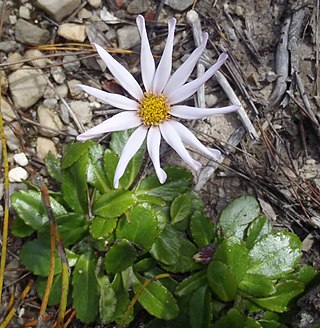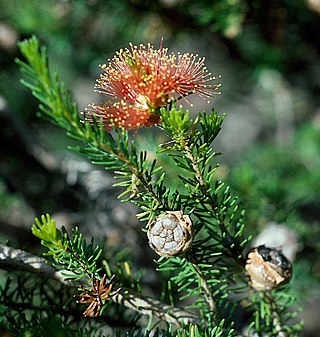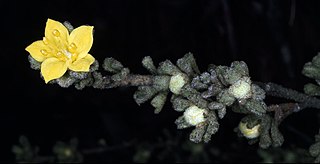
Calocephalus is a genus of flowering plants in the family Asteraceae. It is endemic to Australia, where it is represented in every state.

Eremophila fraseri, commonly known as burra or jilarnu, is a flowering plant in the figwort family, Scrophulariaceae and is endemic to Western Australia. It is a shrub or small tree with all above-ground parts of the plant, apart from the petals, sticky and shiny due to the presence of a large amount of resin. The petals are coloured white, cream, pink and brown.

Bulbophyllum baileyi, commonly known as the fruit fly orchid, is a species of epiphytic or lithophytic orchid that is native to Queensland and New Guinea. It has coarse, creeping rhizomes, curved, yellowish pseudobulbs with a single thick, fleshy leaf, and a single cream-coloured flower with yellow, red or purple spots. It grows on trees and rocks in open forest, often in exposed places.
Dimorphocoma is a genus of flowering plants in the family Asteraceae.

Gymnarrhena is a deviant genus of plants in the family Asteraceae, with only one known species, Gymnarrhena micrantha. It is native to North Africa and the Middle East, as far east as Balochistan. Together with the very different Cavea tanguensis, it constitutes the tribe Gymnarrheneae, and the subfamily Gymnarrhenoideae.

Hymenonema is a genus of flowering plants in the family Asteraceae endemic to Greece. On each of the single or few stems, the species have one to three flowerheads consisting of yellow or yolk yellow ligulate florets, scaly pappus, greyish, pinnately segmented leaves in a basal rosette, and few smaller leaves on the 20–70 cm high stems. It contains two species: Hymenonema graecum, that is known from the Cyclades, and Hymenonema laconicum, which occurs in the central and south-eastern Peloponnesos.

Mairia is a genus of perennial herbaceous plants assigned to the family Asteraceae. All species have leathery, entire or toothed leaves in rosettes, directly from the underground rootstock, and one or few flower heads sit at the top of the stems that carry few bracts. These have a whorl of white to mauve ray florets surrounding yellow disc florets in the centre. In general, flowering only occurs after the vegetation has burned down. The six species currently assigned to Mairia are endemic to the Western Cape and Eastern Cape provinces of South Africa. Some of the species are called fire daisy in English and vuuraster in Afrikaans.

Corymbium is a genus of flowering plants in the daisy family comprising nine species. It is the only genus in the subfamily Corymbioideae and the tribe Corymbieae. The species have leaves with parallel veins, strongly reminiscent of monocots, in a rosette and compounded inflorescences may be compact or loosely composed racemes, panicles or corymbs. Remarkable for species in the daisy family, each flower head contains just one, bisexual, mauve, pink or white disc floret within a sheath consisting of just two large involucral bracts. The species are all endemic to the Cape Floristic Region of South Africa, where they are known as plampers.

Arthrochilus, commonly called elbow orchids, is a genus of about fifteen species of flowering plants from the orchid family (Orchidaceae) and is found in Australia and New Guinea. The flowers are pollinated by male thynnid wasps which attempt to mate with the flower and are held in place by hooks while the pollinium is transferred between insect and flower.

Wilkiea is a genus of flowering plants in the family Monimiaceae, and is native to Australia and New Guinea. Plants in this genus are monoecious or sometimes dioecious trees and shrubs, the leaves with many fine oil dots, male and female flowers in cymes or panicles, and oval black drupes.

Atkinsonia is a hemi-parasitic shrub with oppositely set, entire leaves and yellowish, later rusty-red colored flowers, that is found in Eastern Australia. It is a monotypic genus, the only species being Atkinsonia ligustrina, and is assigned to the showy mistletoe family, Loranthaceae. It is sometimes called Louisa's mistletoe.

Hemiphora is a genus of five species of flowering plants in the mint family, Lamiaceae and is endemic to Western Australia. Plants in this genus are woolly shrubs with warty, hairy leaves and with five petals joined to form a tube-shaped flower with four stamens. These species are similar to those in the genus Chloanthes in that the base of the leaves extends down the stem. They differ from Chloanthes, in that the leaves only extend a short distance down the stem.

Eremaea ebracteata is a plant in the myrtle family, Myrtaceae and is endemic to the south-west of Western Australia. It is a shrub with narrow, mostly linear leaves and which bears orange-coloured flowers on the long branches of the same season's growth. The fruits have a surface that is rough and lumpy.
Myopordon pulchellum is a species of flowering plants in the tribe Cardueae within the family Asteraceae.

Asterolasia phebalioides, commonly known as downy starbush, is a species of shrub in the family Rutaceae and is endemic to south-eastern continental Australia. It has densely crowded heart-shaped to wedge-shaped leaves densely covered with star-shaped hairs, and single yellow flowers borne on the ends of branchlets with star-shaped hairs on the back of the petals.
Teucrium betchei is a species of flowering plant in the family Lamiaceae, and is endemic to eastern Australia. It is a perennial herb or undershrub with rod-like stems, linear to very narrow lance-shaped leaves and white flowers.
Teucrium grandiusculum is a species of flowering plant in the family Lamiaceae and is endemic to central Australia. It is a perennial herb or shrub with toothed, egg-shaped leaves and white flowers.

Teucrium teucriiflorum is a species of flowering plant in the family Lamiaceae, and is endemic to arid and semi-arid areas of Australia. It is a semi-scandent shrub with many branches, linear to narrow lance-shaped or narrow egg-shaped leaves and creamy-white flowers.

Dichosciadium ranunculaceum is a monotypic genus of flowering plants belonging to the family Apiaceae. It is a small, flat perennial1 herb that can grow up to 20 cm wide. The species is commonly referred to as Wreath Pennywort.

Myosotis exarrhena is a species of flowering plant in the family Boraginaceae, endemic to Australia. Robert Brown described this species as Exarrhena suaveolens in 1810. Plants of this species of forget-me-not are perennial rosettes with ebracteate inflorescences and white corollas with exserted stamens.
















